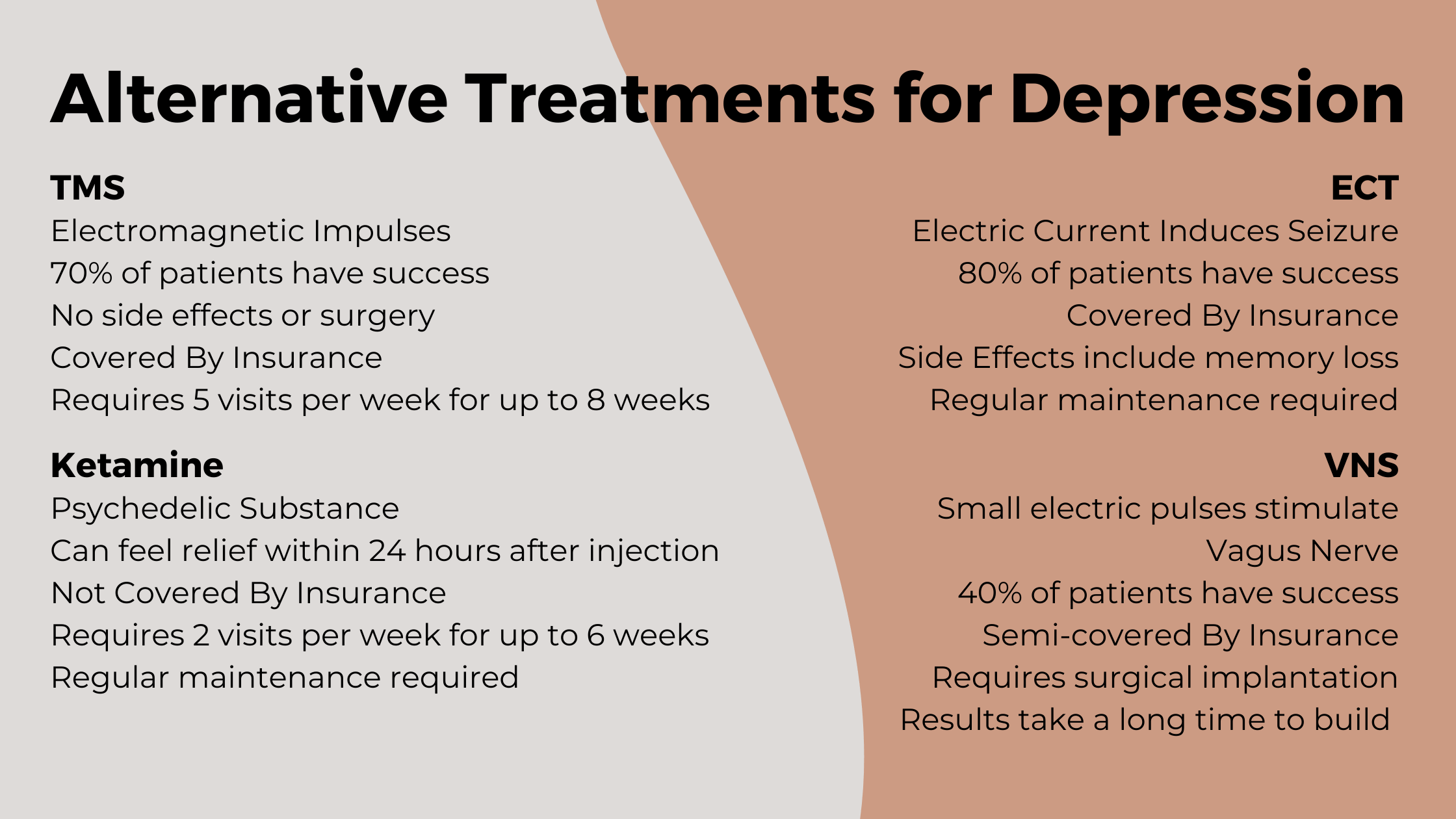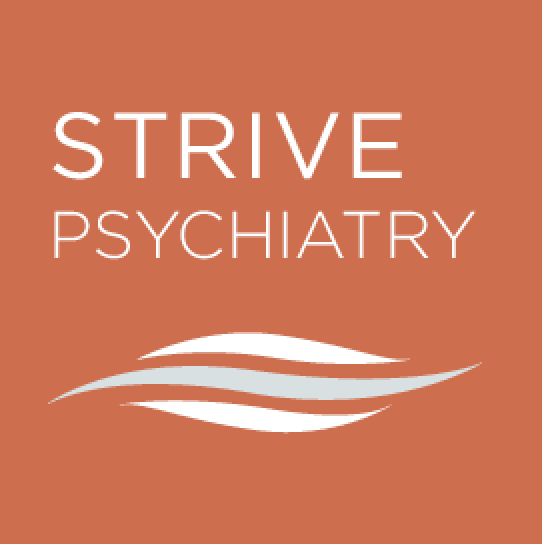Sarah’s Battle
“Maybe the 5th time is the charm!” Sarah muttered to herself. She had just started a new antidepressant. Her first prescription didn’t do anything for her depression, while her third caused her to gain weight and it made her nauseous for hours after taking it. She shook her head at the thought, and read over the prescription information for the 10th time. After a few months of testing out the new antidepressant, Sarah decided it was time to ask her doctor why she was not seeing any improvement. Her doctor concluded that she had Treatment-Resistant Depression. It suddenly all made sense, the ineffective pills, the horrible side effects, and the ever lingering depression. Sarah sighed.
“What now?”
Her doctor went on to tell her that Treatment-Resistant Depression was tricky to treat with conventional medicine and therapy, but there were other successful options she could try. This caught Sarah’s attention. There were more options? For the first time in a long time, Sarah felt hopeful.
Many find that Sarah’s story is familiar. The goal of this blog post is to shine a light on the alternative treatments for depression. This post will cover:
- TMS Therapy
- Ketamine Therapy
- ECT
- Vagus Nerve Stimulation
If you aren’t feeling like reading the whole article, check out our TL;DR at the bottom of the page!
Treatment-Resistant Depression Alternative Options
TMS Therapy

What is it?
Transcranial Magnetic Stimulation – TMS – was first FDA cleared in 2008 as a successful treatment for depression. Since then, TMS has proved to be helpful to those with anxiety, OCD, and PTSD. Along with this, there are clinical trials currently testing the use of TMS for treating chronic pain, bipolar disorder, and addiction. For depression specifically, TMS has a fairly high success rate. Statistics show that about 70% of depressed individuals saw relief, and 40% saw total remission of their depression. To put those numbers into context, antidepressants have a success rate of roughly 30% if it is a patient’s first time trying the medication. That success rate decreases with each consecutive antidepressant change.
How Does it Work?
TMS Therapy utilizes magnetic pulses to stimulate the area in the brain that controls mood and emotions. These areas are underactive in patients with depression and the stimulation reactivates these neural pathways. This leads to relief and remission from depression symptoms. The whole process takes roughly 30 minutes over the course of 6-8 weeks, depending on the clinic. Patients describe the treatment as feeling like a pen tapping against their heads. Side effects are mild and include scalp sensitivity, facial twitching during the session, and mild headaches. These side effects tend to go away upon treatment completion.
The Bottom Line
Because TMS is so effective with minimal side effects, many insurance companies cover the costs. This makes it an excellent option for those with Treatment-Resistant Depression. The main drawback of TMS is that a patient needs to visit a clinic 5 days a week for 6-8 weeks, but many find this is a small inconvenience compared to the reward of living without depression.
Ketamine Therapy

What is it?
Ketamine Therapy is a recently FDA-cleared treatment for Treatment-Resistant Depression, though ketamine itself has been around for a long time. Ketamine is a psychedelic substance created as anesthesia for humans and animals. During the ’60s through the ’80s, it became a popular party drug and was highly abused. Many knew it by the street name Special K. For a more in-depth history of Ketamine, check out our other blog post “Psychedelics and Psychiatry: The History and Drama of Hallucinogenics.”
There are many methods of administering Ketamine; the only FDA-approved one at the time of this post is a nasal spray form called Spravato. Much of the current research argues that the nasal spray form takes effect the slowest, while intramuscular and intravenous are more effective. Many depressed individuals received relief within the first few injections – which makes ketamine life-saving for those who are having suicidal thoughts. It is important to note that most research for ketamine – and other psychedelic substances – as a treatment for mental disorders is relatively new. There is more complete research for the injected form than the nasal spray form. Currently, the studies are not as robust as for TMS, ECT, and Vagus Nerve Stimulation.
How Does it Work?
It is not exactly known how Ketamine works to ease depression. This is not unusual though. There is a large amount of medicine that scientists and doctors aren’t 100% positive of how they work. The most accepted reason is that Ketamine works by binding to receptors in the brain, causing an increase in neural activity. This increase helps to improve mood, emotions, and thought processes. This process is fast-acting, with some patients feeling relief within 24 hours. Depending on the condition, infusions are administered once or twice a week and each session lasts roughly an hour. Typically there are 6 total treatments for injected ketamine and 12 treatments for the nasal spray form. Almost all ketamine clinics encourage maintenance visits after initial treatment completion. These can be as frequent as every 3 weeks and are further spaced out as the patient experiences longer-lasting relief.
The Bottom Line
Those looking for an alternative treatment for their depression often consider cost first. Unfortunately, insurance doesn’t cover ketamine infusions at this time. Many worry about the side effects, which include nausea, vomiting, disassociation (out-of-body experiences,) and disturbances in perception (time slowing down or speeding up, blurry vision, etc.) Many of these side effects ease and disappear after the first few infusions. Because of the speed at which patients feel improvement, Ketamine is an excellent option for many suffering from depression, especially those with suicidal thoughts.
ECT

What is it?
Electroconvulsive Therapy (ECT) might have the most daunting reputation of any psychiatric treatment. Historically, movies and television have portrayed ECT unfairly. Scenes in the media paint terrifying images of pain and medical malpractice. It is important to recognize that media and medical facts don’t always align, which is true for ECT. ECT is the most successful treatment for depression – seeing success rates as high as 80%. Many ECT patients feel relief by the end of their first week of treatment, and more find remission by the end of 4 weeks. The speed of improvement makes ECT life-saving for those with severe depression and suicidal thoughts.
ECT treatments are always conducted while a patient is under anesthesia and after taking a muscle relaxant. The brain is briefly stimulated with electrical impulses which cause a seizure. Patients don’t experience muscle convulsions and cannot feel the electrical current. This all occurs over the course of 5-10 minutes. After a recovery period, the patient should be driven home and monitored by a friend or family member. A patient should not drive a vehicle or operate heavy machinery for 24 hours after their treatment. Generally, a full treatment is 4-6 weeks with appointments 2-3 times a week, depending on the patient.
How Does it Work?
Like many other medical treatments, no one is 100% sure how exactly ECT works. Many believe ECT improves depression by causing the brain to release serotonin and dopamine – both of which help regulate mood and emotions. Other popular theories state that ECT “rewires” the brain, which improves underactive neural pathways thereby improving communication with other brain sections.
The Bottom Line
While treatment is highly effective, the results are not long-lasting. Patients need regular maintenance, but this doesn’t necessarily mean continued ECT. After a completed ECT plan, many patients continue therapy or start on an antidepressant and find great success. ECT can be expensive, but many insurance plans cover the treatments.
The greatest drawback of ECT is the side effects, including memory loss, specifically that of short-term memory. Those who have had this side effect mostly report not remembering specific things in the days and weeks before the procedure. Memory creation is also affected and some patients report difficulty forming new memories after the treatment. This subsides in the weeks and months post-treatment. Confusion, muscle aches, and nausea are not uncommon after each ECT session. If most other treatments fail to provide relief for those suffering from major depression, ECT offers substantial relief and hope.
Vagus Nerve Stimulation

What is it?
Vagus Nerve Stimulation (VNS) was not originally a treatment for depression. While studying a treatment for epilepsy, scientists found that stimulating the Vagus Nerve could help prevent seizures. This treatment utilizes a small device surgically placed below the skin of the chest. While checking in with patients, doctors noticed an overall improvement in mood. This lead to research into VNS for Treatment-Resistant Depression. By 2005, the FDA cleared VNS as a treatment for depression. Clinical trials found that the effects of VNS tended to improve over time. While 40% saw improvement within three months, only 17% reached remission within the first 3 months. Then, after 1 year of having the device implanted, those numbers rose to 46% of patients seeing improvement and 29% reaching remission. A nice bonus about VNS is that a patient doesn’t have to do anything to maintain their device once it is surgically placed.
How Does it Work?
Like the other alternatives for treating depression, the exact reason that VNS works is unknown. Doctors believe that the electrical impulses emitted by a VNS device affect the way nerve cells carry and transfer signals within the brain. This leads to improved mood and a decrease in depression symptoms over the course of several months.
The Bottom Line
There is some controversy within many medical circles in regard to how effective VNS is. In comparison to other treatments, some may see this treatment as nothing special. Plus the added need for surgery might discourage many from choosing this treatment. Though it is not as popular as other treatments, for those who have debilitating depression, VNS offers hope for relief and remission. Depending on the insurance provider and the severity of the condition, a patient may have to pay out of pocket.
So what happened to Sarah?
Sarah’s family came together and helped her look into the different options available to her. After researching some more, Sarah chose a treatment plan that worked best with her lifestyle. Though medication didn’t work for her, TMS Therapy helped her conquer her depression.
TL;DR
There are alternative treatment options out there for anyone looking to overcome their Treatment-Resistant Depression. It is never wrong to reach out for help or seek a different route.

Related Posts:
PSYCHEDELICS AND PSYCHIATRY: THE HISTORY AND DRAMA OF HALLUCINOGENICS
TMS THERAPY AS AN ALTERNATIVE TO ANTIDEPRESSANTS
TMS
https://www.clinicaltmssociety.org/
https://www.nimh.nih.gov/funding/clinical-research/practical/stard/
Ketamine
https://www.ncbi.nlm.nih.gov/pmc/articles/PMC6767816/
ECT
https://www.hopkinsmedicine.org/news/articles/how-ect-relieves-depression
https://www.hopkinsmedicine.org/psychiatry/specialty_areas/brain_stimulation/ect/faq_ect.html
https://jamanetwork.com/journals/jamapsychiatry/fullarticle/2680312
https://www.psychiatry.org/patients-families/ect
VNS


3 Comments